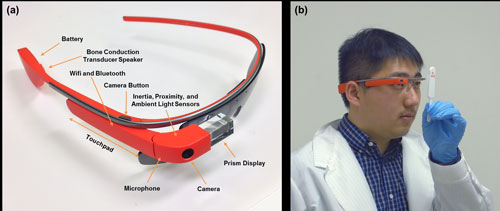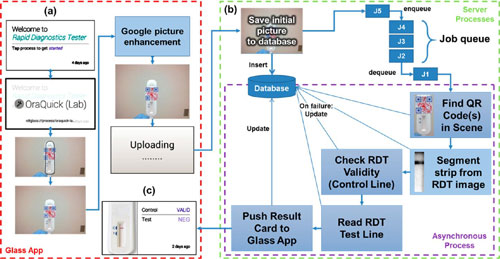| Posted: Mar 04, 2014 | |
A Google Glass app for instant medical diagnostics (w/video) |
|
| (Nanowerk Spotlight) The integration of consumer electronics with advanced imaging and analytical platforms holds great promises for medical point-of-care diagnostics and environmental rapid field testing for pollutants and viruses. For instance, in a recent Nanowerk Spotlight we reported on the use of smartphones to detect single nanoparticles and viruses. In this work, a research group led by Aydogan Ozcan, a professor in the Electrical and Bioengineering Department at UCLA and Associate Director of the California NanoSystems Institute (CNSI), created a field-portable fluorescence microscopy platform installed on a smartphone for imaging of individual nanoparticles as well as viruses using a light-weight and compact opto-mechanical attachment to the existing camera module of the cellphone. | |
| In new work, Ozcan's group has now developed a Google Glass application and a server platform for instant, wireless diagnostic testing of a variety of health conditions and diseases. | |
| "This technology allows Google Glass wearers to use the hands-free camera on the device to send images of diagnostic tests that screen for conditions such as HIV or prostate cancer," Ozcan explains to Nanowerk. "Without relying on any additional devices, Google Glass users can upload these images and receive accurate analysis of health conditions in as little as eight seconds." | |
 |
|
| Labeled Google Glass and demonstration of imaging a rapid diagnostic test (RDT). (a) Front-profile view of the Google Glass with various hardware components36 labeled. (b) Example of using the Glass for taking an image of an RDT as part of our RDT reader application. (Reprinted with permission from American Chemical Society) (click image to enlarge) | |
| This is the first biomedical sensing application created through Google Glass. This breakthrough technology takes advantage of gains in both immunochromatographic rapid diagnostic tests (RDTs) and wearable computers (such as Google Glass). | |
| The team reported their findings in the February 27, 2014 online edition of ACS Nano ("Immunochromatographic Diagnostic Test Analysis Using Google Glass"). | |
| Over the past decade, RDTs – which are in general based on light scattering off surface-functionalized metallic nanoparticles – have emerged as a quick and cost-effective method to screen various diseases and have provided various advantages for tackling public health problems including more effective tracking/monitoring of chronic conditions, infectious diseases and widespread medical testing by minimally trained medical personnel or community healthcare workers. | |
| The new Google Glass-based diagnostic technology could improve individual tracking of dangerous conditions or diseases, public health monitoring and rapid response in disaster relief areas or quarantine zones. | |
| This is how it works: The user takes a photo of the RDT device through the camera system in Google Glass. Using a Quick Response (QR) code identifier, which is custom-designed and attached to each RDT cassette, this custom-written Glass application is capable of automatically finding and identifying the type of the RDT of interest, along with other information (e.g., patient data) that can be linked to the same QR code. The data is transmitted to a central server which has been set up for fast and high-throughput evaluation of test results coming from multiple devices simultaneously. | |
| The data is processed automatically and to create a quantitative diagnostic result, which is then returned to the Google Glass user. | |
| Here is how it looks through the screen of Google Glass during imaging and quantification of a diagnostic test. | |
| "We also developed a centralized database and Web interface for visualizing uploaded data in the form of geo-tagged map data, which can be quite useful for short- and long-term spatiotemporal tracking of the evolution," says Ozcan. "This web portal allows users to view test results, maps charting the geographical spread of various diseases and conditions, and the cumulative data from all the tests they have submitted over time." | |
| He also points out that the precision of the Google Glass camera system permits quantified reading of the results to a few-parts-per-billion level of sensitivity – far greater than that of the naked eye – thus eliminating the potential for human error in interpreting results, which is a particular concern if the user is a health care worker who routinely deals with many different types of tests. | |
 |
|
| Block diagram of the rapid diagnostic test (RDT) imaging and processing workflow (a, c) done by the Google Glass application (red dashed frame) and server processes (green dashed frame). In this case, a single RDT is analyzed. (Reprinted with permission from American Chemical Society) (click image to enlarge) | |
| The team tested their Google Glass-based RDT reader platform through commercially available human immunodeficiency virus (HIV) and prostate-specific antigen (PSA) rapid tests. The researchers took images of tests under normal, indoor, fluorescent-lit room conditions. They submitted more than 400 images of the two tests, and the RDT reader and server platform were able to read the images 99.6 percent of the time. | |
| Ozcan notes that, for wide-scale deployment and use of this Google Glass application, the sales price of Glass should be cost-effective enough to compete with mobile phones and low enough to enter developing markets. "We are quite hopeful on this end as Google is very well aware of all these emerging opportunities." | |
 By
Michael
Berger
– Michael is author of three books by the Royal Society of Chemistry:
Nano-Society: Pushing the Boundaries of Technology,
Nanotechnology: The Future is Tiny, and
Nanoengineering: The Skills and Tools Making Technology Invisible
Copyright ©
Nanowerk LLC
By
Michael
Berger
– Michael is author of three books by the Royal Society of Chemistry:
Nano-Society: Pushing the Boundaries of Technology,
Nanotechnology: The Future is Tiny, and
Nanoengineering: The Skills and Tools Making Technology Invisible
Copyright ©
Nanowerk LLC
|
|
|
Become a Spotlight guest author! Join our large and growing group of guest contributors. Have you just published a scientific paper or have other exciting developments to share with the nanotechnology community? Here is how to publish on nanowerk.com. |
|
